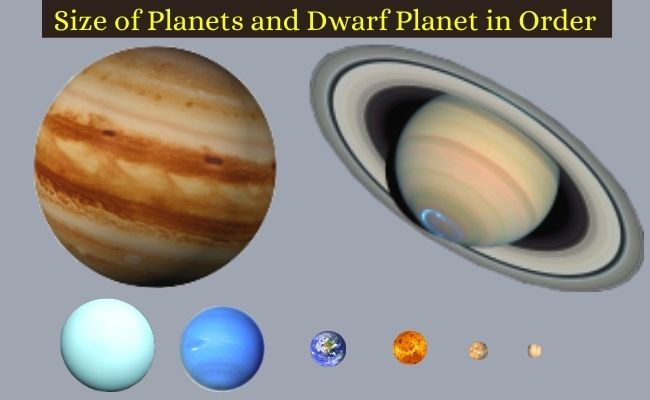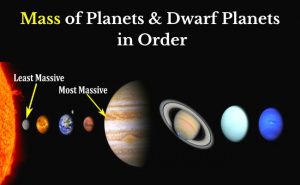You may have looked up in the sky and have found small appeared planets. But the actual sizes of all planets are different. Some planets are small but some are very large in size.
Some people do not know the size of planets in order. Here in this article, you will know Planets in Order of Size. You will also know some other facts and information about the size of planets, such as the smallest planet in the solar system, the largest planet, the diameter of planets in order, and planets size comparison.
As we know, there are eight planets in our solar system and each of them has different physical properties, like, their composition, volume, temperature, gravity, mass, and other properties are different.
Here you will find the planet’s size, especially considering the diameter.
Size of All Planets in Order
Of all 8 planets, Mercury is the smallest planet in the solar system, whereas Jupiter is the largest planet. All other planets have different size scales, which you will see below in the table.
Below you will see the Planets in Order of Size, including Pluto and other dwarf planets with the sun and moon size. These size of planets in order are given in diameter in two units miles and kilometers.
Here the size of the planet is compared to Earth’s size. Also, some other facts and information are given for the term All Planets Size.
The Planets in Order of Size are Mercury, Mars, Venus, Earth, Neptune, Uranus, Saturn, and Jupiter.
Below is the given size chart of planets in diameter. Every object in the solar system is not a perfect sphere, so the mentioned size is in form of an Average or Mean Diameter.
| Size of Mercury | 4880 km (3032 mi) |
| Planet Mercury is the closest to the sun and it is also the smallest planet in our solar system. The size of Mercury is just 0.38 times of the earth. This planet is just a little larger than our moon. | |
| Size of Mars | 6779 km (4212 mi) |
| According to location Mars is the fourth planet from the sun. But according to size, the red planet Mars is the second smallest planet in our solar system. The size of Mars is 0.53 times compared to earth. | |
| Size of Venus | 12104 km (7521 mi) |
| Venus is the third smallest planet in our solar system. It is just a little smaller compared to our earth. While compared to earth, the size of Venus is just 0.95 times earth’s size. Because its size nearly matches earth, Planet Venus is also known as Earth’s sister. | |
| Size of Earth | 12742 km (7917.5 mi) |
| Earth is the largest terrestrial planet in the solar system. It is the fourth-smallest planet and a little larger than planet Venus. According to diameter, the size of the Earth compared to the sun is around 1/109 times. | |
| Size of Neptune | 49244 km (30599 mi) |
| Neptune is the smallest giant planet and the fifth-smallest planet in our solar system. It is smaller than planet Uranus but heavier in mass, because of the high density of Neptune. Neptune’s size compared to Earth is around 3.85 times. | |
| Size of Uranus | 50724 km (31518 mi) |
| Uranus is the sixth smallest and third-largest planet in our solar system. It is larger than planet Neptune but the mass of this planet is lower, because of its lower density. Uranus is approximately 4 times larger than our Earth. | |
| Size of Saturn | 116464 km (72367 mi) |
| Planet Saturn is the seventh-smallest and second-largest planet in our solar system. This planet is quite big and it is around 9 times larger than earth according to its diameter. | |
| Size of Jupiter | 139822 km (86881 mi) |
| Jupiter is the largest planet in our solar system. It is made of gages still it is too heavy because of its enormous size. This huge planet is approximately 11 times larger compared to earth in terms of size in diameter. | |
So, these were the size of planets in order from smallest to largest. 1st one Mercury is the smallest and the 8th one Jupiter is the largest, according to the order of size.
Size of All 5 Dwarf Planets in Order
Below are the 5 dwarf planets in order of size, recognized by the IAU (International Astronomical Union ).
| Size of Ceres | 940 km (584 mi) |
| Ceres is the smallest dwarf planet. It is the only dwarf planet that exists in the asteroid belt region. | |
| Size of Makemake | 1440 km (895 mi) |
| Makemake is the second smallest dwarf planet. It exists in the Kuiper Belt region. | |
| Size of Haumea | 1632 km (1014 mi) |
| Haumea dwarf planet also exists in the Kuiper Belt region and it is the third-smallest dwarf planet in our solar system. | |
| Size of Eris | 2330 km (1448 mi) |
| Eris is the fourth-smallest dwarf planet and it is slightly smaller than dwarf planet Pluto. | |
| Size of Pluto | 2380 km (1479 mi) |
| Pluto is the largest dwarf planet in our solar system. It used to be a planet but in 2006 IAU categorized it into a Dwarf Planet List. | |
Size of the Sun and Moon
Below you will get to know the size of the Sun and the size of our moon in terms of diameter. The units are already mentioned (size in kilometers and miles).
| Size of Sun | 1,392,680 km (865,371 mi) |
| Sun is a star and it is the largest object in our solar system. The diameter of the sun is around 109 times of the earth. But according to volume, the sun is approximately 1,300,000 times bigger than Earth. It means, that around 1,300,000 Earth-size objects can fit inside the Sun. | |
| Size of Moon | 3475 km (2159 mi) |
| The moon is earth’s only natural satellite. The size of the moon is around 0.27 times compared to the earth in terms of diameter. | |
So, here in this article, you got to know the planets in order of size. As you got to know, Jupiter is the largest planet and Mercury is the smallest planet in our solar system.
Also, you read here about the size of dwarf planets, and the size of the sun and moon.
What is the list of Planets in order of size?
The planets in order of size from minimum to maximum are Mercury, Mars, Venus, Earth, Neptune, Uranus, Saturn, and Jupiter. Thus, Jupiter is the largest and Mercury is the smallest world.
Related Posts of Planets Education:-
- Density of All Planets in Solar System With Facts
- How Long is a Day and Year on each Planet
- Closest and Farthest Distance of Planets from Sun
- 5 Best Solar System Backpacks in 2024
- Mass of Planets in Order from Lightest to Heaviest
- Star Projector {2024}: Star Night Light Projector





Pingback: The Largest and Smallest Planets in Our Solar System - User's blog
Comments are closed.